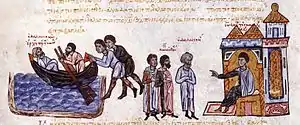Yassıada
Democracy and Freedom Island,[1] also known as Yassıada (meaning "Flat Island" in Turkish) is one of the Princes' Islands in the Sea of Marmara, to the southeast of Istanbul. The island was named Yassıada until 2013, when it was renamed “Democracy and Freedom Island” in order to remember the 1960 military coup, the first in the history of the republic.[2] In the past, the island was named Plati (Greek: Πλάτη). The island, which has an area of 0.05 km², is officially a neighbourhood in the Adalar (meaning "Isles" in Turkish) district of Istanbul Province, Turkey.


Yassıada was used by the Byzantines for sending prominent figures into exile. One such person was the Armenian Patriarch (Catholicos) Narses who was first sent to this island before being imprisoned at Prinkipos in the 4th century AD. In the 11th century AD the Byzantines used the island for political prisoners. The remains of the 4 underground prison cells from this period can still be seen. The Byzantine Emperor Theofilos, built the Platea Monastery on the island. Patriarch Ignatios, who was exiled to the island in 860, had built a church. Tunnels under the church were used as a dungeon.[2] Yassıada (Plati) was captured by the Latin Crusaders during the Fourth Crusade in 1204.
In 1857, Yassıada was purchased by the British ambassador Henry Bulwer, brother of novelist Edward Bulwer-Lytton, who built himself a mansion and a number of other structures to live undisturbed on this distant island. Henry Bulwer also organized agricultural production on the island to self-sustain his little realm at least to a certain degree, but later sold Yassıada to the Khedive of Ottoman Egypt and Sudan, Ismail Pasha; who, however, didn't construct any new buildings and completely neglected the island.
With the establishment of the Republic of Turkey in 1923, the island became a property of the Turkish state, and in 1947 Yassıada was handed over to the Turkish Navy which built several school buildings. Between 1960 and 1961, these school buildings became the venue for the trials of the members of the former ruling party, Demokrat Parti, after the military coup of 1960. Several of the defendants were sentenced to death, and three of these, including the former Prime Minister Adnan Menderes, were taken to İmralı Island (further southwest, near the southern shoreline of the Sea of Marmara) and executed there in 1961.
After the end of the trials, Yassıada was given back to the Turkish Navy and lessons continued to take place at the naval school buildings until 1978.
In 1993, the island became a property of Istanbul University's department of Marine Life and Sea Products, which used it for lessons and research. However, the strong winds on the island made life difficult for the students and eventually classes were held elsewhere.
Today, the island is a favourite location for scuba diving schools and amateur divers.
Rename and restructure
The island was home to the infamous trial of then Turkish Prime minister Adnan Menderes and ministers Fatin Rüştü Zorlu and Hasan Polatkan, which was resulted with execution order. After the 1960 coup "Yassıada" name was remembered negatively, which led the island to be renamed as "Democracy and Freedom Island" on November 7, 2013.[1]
After renaming, the island went into major restructure in 2015. On 27 May 2020, President Erdoğan opened the island with a ceremony including “27 May Museum”, a convention center, an hotel and a mosque.[3]
References and notes
- "Infamous Istanbul island home to Menderes' trial renamed 'Democracy and Freedom Island'". Hürriyet Daily News. Retrieved 14 December 2013.
- Yassıada to become ‘Island of Democracy and Freedom’
- "Betonada'ya dönüştürülen Yassıada 27 Mayıs'ın yıl dönümünde açılıyor". Yeşil Gazete - ekolojik, politik, katılımcı, şenlikli... (in Turkish). 27 May 2020. Retrieved 28 May 2020.